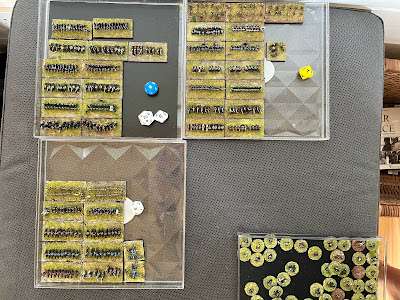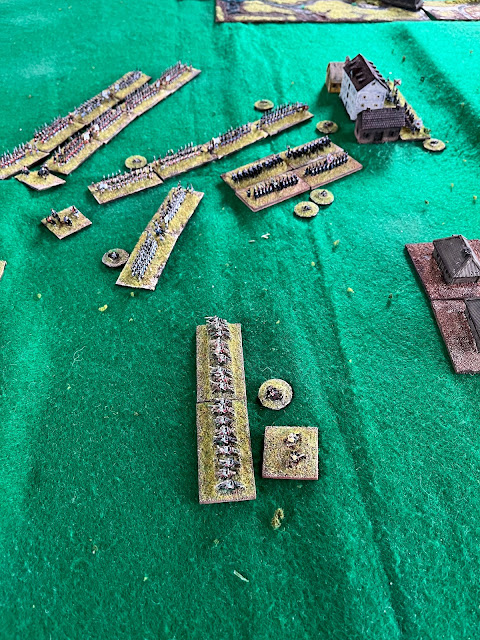Rossbach, Take II. A victory for Prussia, but not overwhelming. This time it played out differently to yesterday. The Prussians won, but not by a big margin. Certainly not the historical cataclysm endured by the real French and Imperialists.
Break points for the 3 armies were:
French - 10
Imperialists - 5
Prussian - 8
This game finished after 29 turns with the following losses:
French - 10
Imperialists - 4
Prussians - 3
So this one finished much better for the Prussians, but not a crushing victory. It appears close to a total victory on paper, but there was no prospect of the Prussians getting that final victory point over the Imperialists in the last turn. That was because once the Imperialists had lost all they cavalry (3 points down) they stayed well out of the action. The only unit left in real danger were Loudon's Grenzers. They eventually were routed, but the Reichsarmee had one VP left in the bank at close of play (notionally when night fell).
The reasons for the victory were that the Prussians got a shift on sooner - I started dicing for this rather than waiting for the Allies to reach Pettstädt. Accordingly, they were able to cross the T and form in two lines ahead of the Imperialists, and successfully charge them.
The French were a bit delayed at Zeuchfeld - not for long, but long enough. [You have to dice for a change of direction in TOTSK]. So the Allied cavalry were beaten piecemeal. Whilst the Prussian hussars repeated their trick of appearing to threaten the Allied infantry columns, they did not stray too close to the French cavalry.
However, once the Imperialist cavalry had been defeated, the Allied infantry, guns and remaining horse began to deploy across the valley from east of Pettstädt to Rossbach. There was quite a traffic jam as the space was limited and, without the Improved Movement facility of the Prussians, forming line from column is a laborious process. Whilst this was going on the Prussian cavalry, infantry and guns, who had reached the vicinity of the Janus Hill, began to head back (west) to face the French. Eventually the Prussians prevailed, but it took until the completion of turn 29. By then it was too late to deliver the coup de grace to Hildeburghausen and his Kaiserlicks.
This just reinforced in my mind how timing was paramount, and everything had to go correctly for the Prussians to win as convincingly as they did in real life.
 |
| Imperial cavalry start to pull away from the rest as they race for the objectives. The Prussians have got moving slightly earlier than the last game. |
 |
| The Imperialist cavalry attempt to deploy from column into line, under fire from Möller's guns on the Janus. The Prussian Garde du Corps and Gendarmes approach from the bottom right. |
 |
| Swirling cavalry action. The Imperialists are totally disrupted. Prussian hussars (right) led by Fritz himself have just smashed one Allied unit . |
 |
| Turn 15 and the cavalry action is almost over. For now. |
 |
| The French form lines (right) as the Prussian infantry begin to head back their way. On the right just next to Rossbach village, Prussian grenadiers try to seal off this flank. |
 |
| Four turns later, the French had been nudged on to 10 losses, with no further Prussian or Imperialist units lost, although several of Frederick's units were getting close to breaking. |
In this alternative history, the Reichsarmee live to fight another day, even if that day is a long way off, and the French had taken a battering with all their cavalry scattered. The bonfires will be lit in England but everyone will be slightly more reserved in their celebrations than they were in the real world. Frederick, of course, will still have to face the Austrians once more. It's always the Austrians.
UPDATE: ADDED
 |






































